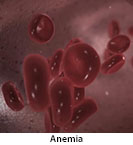
Thalassemia (Blood Disorder)
________________________________________________________________________
KEY POINTS
- Thalassemia is a blood problem that causes your child’s red blood cells to be unable to carry all of the oxygen the body needs.
- There a several types of thalassemia that can cause mild to severe symptoms.
- Treatment depends on the severity and can include blood transfusions, iron chelation therapy, or a bone marrow transplant.
________________________________________________________________________
What is thalassemia?
Thalassemia is caused by a problem with the way the body makes hemoglobin. Hemoglobin is the part of red blood cells that carries oxygen to all parts of the body. When a child has thalassemia, the red blood cells have less hemoglobin than normal. The cells don’t last as long in the blood stream as normal red blood cells, and this causes anemia. Anemia means that your child doesn’t have enough red blood cells, or enough normal hemoglobin in the red blood cells, to carry all of the oxygen the body needs.
What is the cause?
Thalassemia is inherited, which means that it is passed from parents to children through their genes. Genes are inside each cell of the body. They contain the information that tells the body how to develop and work.
Thalassemia is caused by a problem with the genes that make hemoglobin. There are different forms of thalassemia, depending on which genes are affected.
Thalassemia is most common among people of Mediterranean descent, such as Italians and Greeks. It is also found among people from the Arabian Peninsula, Iran, Africa, Southeast Asia, India, and Southern China.
What are the symptoms?
The symptoms depend on the form and severity of the disease. Some children have no symptoms or very mild symptoms. Others with a very severe form of the disease die before or shortly after birth.
More severe forms of the disease may cause symptoms in early childhood such as:
- Tiredness and weakness
- Pale skin or yellowing of the skin (jaundice)
- Shortness of breath
- Large belly
- Dark urine
- Abnormal facial bones and slowed growth
How is it diagnosed?
Your child’s healthcare provider will ask about your child’s symptoms and medical history and examine your child. Your child will have blood tests. A family history and tests of the blood of family members may also help make the diagnosis.
DNA testing during pregnancy with either amniocentesis or chorionic villus sampling (CVS) can show if a baby will have the disorder and how severe it is likely to be.
How is it treated?
Treatment depends on the type of thalassemia and how severe it is.
- There may be times when children with moderate forms of the disorder need blood transfusions such as when they are under stress or have an infection.
- A child with severe thalassemia needs:
- Regular blood transfusions to give your child healthy blood cells from donors
- Iron chelation therapy, which is medicine given to remove excess iron from the body (children with thalassemia can have a problem called iron overload, which means there is too much iron in their body)
- Bone marrow transplants to give your child healthy blood-making cells from donors
Without treatment, severe thalassemia can lead to heart and liver problems.
How can I take care of my child?
Follow the full course of treatment prescribed by your child's healthcare provider. In addition:
- Make sure your child eats a healthy diet. Your healthcare provider may also recommend folic acid supplements.
- Children should not take vitamins or other supplements that contain iron. Iron supplements do not help this kind of anemia because a lack of iron is not the problem.
- Children with thalassemia can get infections more easily. Make sure your child gets a flu shot every year and the pneumococcal vaccine to help prevent infections.
Ask your child’s healthcare provider:
- How and when you will get your child’s test results
- If there are activities your child should avoid and when your child can return to normal activities
- How to take care of your child at home
- What symptoms or problems you should watch for and what to do if your child has them
Make sure you know when your child should come back for a checkup. Keep all appointments for provider visits or tests.
Last modified: 2017-04-12
Last reviewed: 2017-04-10

